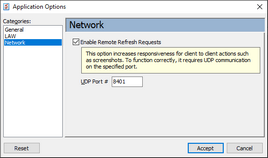You can configure LMC settings that control system timeout, polling interval, whether unresponsive clients are restarted, the executable instance of CloudNine™ LAW to use, and how remote refresh requests are handled.
1.In the LMC, on the Tools menu click Options. The Application Options dialog box appears.
2.Configure the LMC as needed using the settings provided in the Options dialog box.
Category
|
Option and Description
|
General
|

|
System Idle Timeout
Allows a client not in use for this number of seconds to join a shared batch.
The default value is 30 seconds.
A client is determined as in use if mouse or keyboard activity occurs during the timeout interval. For example, if this is set to 60, the LMC cannot join the client until the client is idle for one minute.
•To prevent the client from ever automatically joining a shared batch set the value to 0. •If the system idle timeout value is reached, the LMC reads as System Idle: YES. •If the value is never reached, the LMC reads as System Idle: NO. •To determine whether the idle timer status, look at the second panel in the task bar. |
Polling Interval
Determines the frequency by which the LMC updates its status and retrieves data about clients.
The default value is 10 seconds. The maximum value is 65.
It is important to note that the LMC is a single threaded application and therefore user-interaction with the interface incurs a small delay while it is updating the interface. Under normal conditions this is extremely negligible and almost cannot be noticed. This delay can be mitigated somewhat by reducing the polling interval. The lower the value, the less latency experienced in the interface, but the trade-off is network and database traffic. The default value is 10 seconds.
|
Auto Restart Client
The number of minutes to wait before restarting the client with a status of Not Responding.
The default value is 3 minutes.
•To prevent the client from restarting automatically set the value to 0. •All unattended restart actions are executed by the local LMC instance relative to LAW instance that is not responding. •Unattended restarts are logged into the applications main log and are visible in the log interface. An entry in the Job Log indicates whether an LMC instance executed an unattended restart of its Local LAW instance. •Unattended restart activity is visible in the LMC Jobs panel in the client activity area. •If the LAW client is restarted automatically then the following message is registered in the application log: System[<LMC Local Computer Name>] is forcing automatic restart of Client [Client Name]
|
LAW
|

|
LAW50.exe
Determines which instance of LAW is started.
Typically, if you run a shared Law50.exe from a network drive mapped to a server instance of LAW, then it is recommended that you use that mapped instance of Law50.exe for processing.
|
Network
|

|
Enable Remote Refresh Requests
Enables client-to-client operations, such as screenshots and requests to leave jobs.
This setting defaults to enabled.
The LMC communicates actions between clients by using a central message store. When a client requests an action from another client, the message is placed into the store, and the recipient client gets the message the next time it refreshes.
Since clients refresh at an unsynchronized interval, there could be a delay in retrieving the message by the recipient client. This option sends a UDP packet to the recipient client requesting that it refresh immediately, thereby reducing the time it takes to retrieve and process the message.
|
UDP Port #
Specifies the port for the current client to use as UDP listener.
The default value is 8401.
This port enables the client to determine whether other clients are connected.
It is not necessary that this value be the same for all clients. However, for ease of configuration using the default port for all clients is recommended.
When the LMC starts, or if changes are made to this setting, an entry is placed into the application log.
|
3.When finished configuring click Accept.
|



